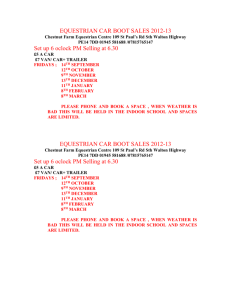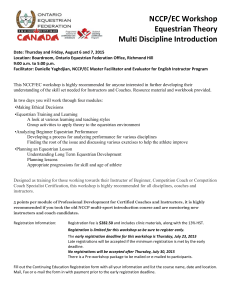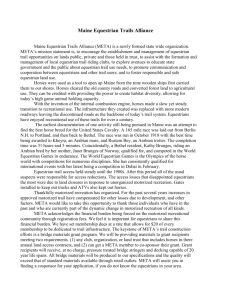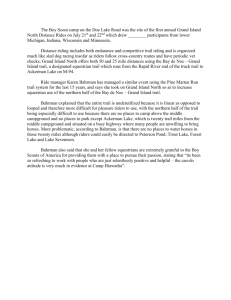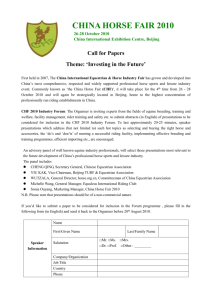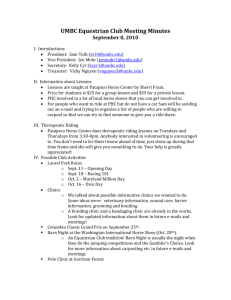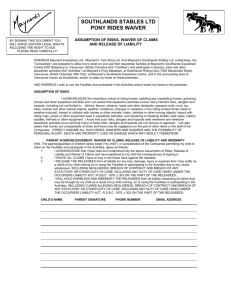Understanding Horses and Mules
advertisement
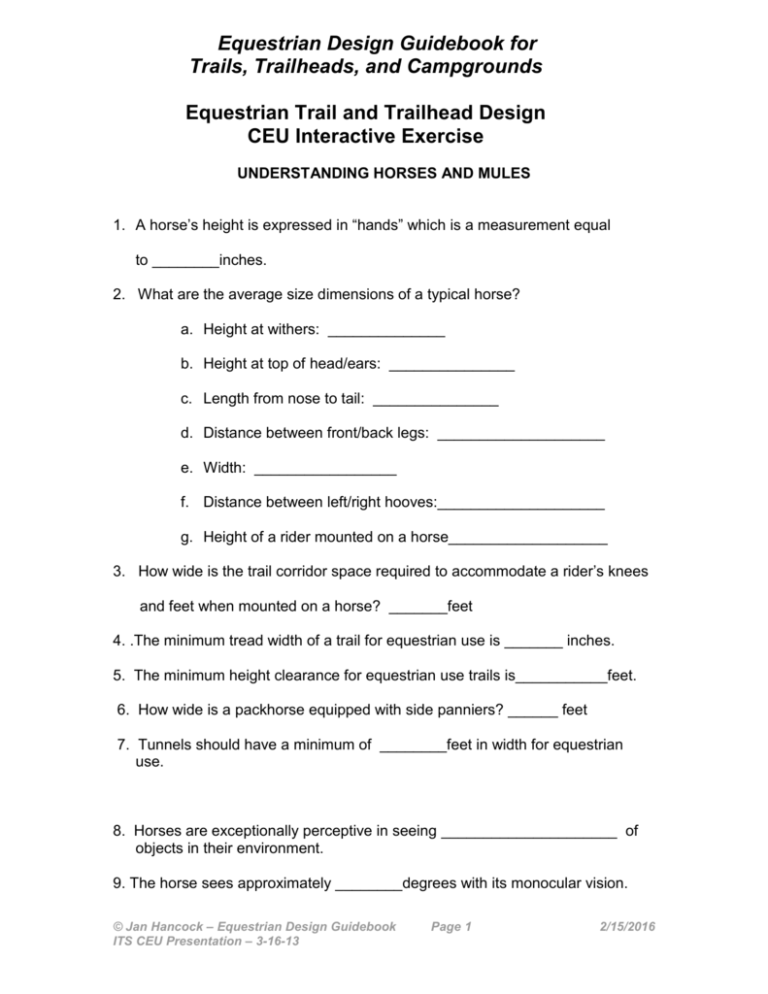
Equestrian Design Guidebook for Trails, Trailheads, and Campgrounds Equestrian Trail and Trailhead Design CEU Interactive Exercise UNDERSTANDING HORSES AND MULES 1. A horse’s height is expressed in “hands” which is a measurement equal to ________inches. 2. What are the average size dimensions of a typical horse? a. Height at withers: ______________ b. Height at top of head/ears: _______________ c. Length from nose to tail: _______________ d. Distance between front/back legs: ____________________ e. Width: _________________ f. Distance between left/right hooves:____________________ g. Height of a rider mounted on a horse___________________ 3. How wide is the trail corridor space required to accommodate a rider’s knees and feet when mounted on a horse? _______feet 4. .The minimum tread width of a trail for equestrian use is _______ inches. 5. The minimum height clearance for equestrian use trails is___________feet. 6. How wide is a packhorse equipped with side panniers? ______ feet 7. Tunnels should have a minimum of ________feet in width for equestrian use. 8. Horses are exceptionally perceptive in seeing _____________________ of objects in their environment. 9. The horse sees approximately ________degrees with its monocular vision. © Jan Hancock – Equestrian Design Guidebook ITS CEU Presentation – 3-16-13 Page 1 2/15/2016 10. Many horses have difficulty seeing objects approximately _______feet below their normal line of sight and objects that are directly in front of them. 11. True or False: Horses’ eyes can see more at night than the human eye. (Circle correct answer.) 12. True or False: Horses eyes adjust quickly to changes in light. (Circle correct answer.) 13. True or False: Horses can breathe through their nostrils and their mouth. (Circle correct answer.) 14. True or False: Horses have a poor sense of smell. (Circle correct answer.) 15. True or False: Horses need at least 8 gallons of water per day. (Circle correct answer.) TYPICAL HAZARDS TO HORSES AND MULES 16. Horses and riders can easily activate Africanized _______________on trails. 17. The living tissue under a horse or mule hoof is called a _________________ 18. Horses can easily slip or fall on _________________surfaces. 19. Underground _________________can cause a horse or mule to break a leg. 20. Horses are very susceptible to _______________________and can feel Vibrations in the ground and on bridges. 21. Some common vegetation, such as ______________________, water hemlock, yellow star thistle, and black walnut can be poisonous to horses. EQUESTRIAN TRAIL DESIGN AND PLANNING ELEMENTS 22. The average gait of an equine can help determine the time and distance an equestrian travels. List the three typical gaits of a horse and the average speed per hour for each: © Jan Hancock – Equestrian Design Guidebook ITS CEU Presentation – 3-16-13 Page 2 2/15/2016 Type of Equine Gait Average Number of Miles Per Hour 23. Equestrian trails should be a minimum of _____________miles in length and preferably designed to be a ________________trail as opposed to a straight point-to-point trail. 24 Trails need to be a minimum of ________feet in width to accommodate harness horses and carts going in opposite directions. 25. The desired minimum radius of a trail’s climbing turn or switchback for equestrians’ use is ___________feet. The ideal radius is _________feet. 26. Steps used on equestrian-use trails should have a minimum horizontal threshold depth of ________feet. 27. Trails with __________________________often have the outer edges damaged by equestrian use. 28. To help prevent erosion, horse trails can utilize rolling _________________ dips and grade reversals instead of water bars. 29. Rock or vegetative _________________________can help prevent trail erosion. 30. Stream crossings and wet trail areas can be strengthened through the use of __________________________________. 31. Equestrian trails should cross roadways at a ________________degree angle to maximize the sightlines for both riders and roadway drivers. 32. Roadway crossings need to provide a ____________________area for horses and riders waiting for traffic to make a safe crossing. 33. Non-textured paved or hard surface roadway crossings can create a © Jan Hancock – Equestrian Design Guidebook ITS CEU Presentation – 3-16-13 Page 3 2/15/2016 dangerous ____________________________hazard for equines. 34. Equestrian trail roadway crossings can be enhanced with the addition of a traffic light actuator mounted at approximately ______________inches from the ground level. 35. Bridges need to be a minimum of _________feet in width for equestrian use. 36. Bridge side barrier rails should be a minimum of _________inches high. EQUESTRIAN TRAILHEAD DESIGN AND PLANNING ELEMENTS 37. The ideal parking pattern for equestrian trailheads is for _______________________________parking spaces. 38. How wide should a trailhead parking space be for a horse trailer plus the staging area for grooming and tacking up a horse? __________ feet 39. What is the approximate turning radius of a 3-horse trailer and pulling vehicle? ____________ feet 40. The first _________ mile of trail leading out of a shared-use trailhead should separate equestrians from other trail users’ trails to help reduce the amount of equine manure usually found on these concentrated trail areas. 41. Roadways in equestrian trailheads and campgrounds are safer if they are ______________________traffic only. 42. Equestrian trailheads and campgrounds should be designed with ____________________curbing to minimize the tripping hazard for horses. 43. Trailhead watering troughs need to have a ____________________so users can help protect their animals from disease or insects. 44. Provide ________________to encourage equestrians to manage manure . © Jan Hancock – Equestrian Design Guidebook ITS CEU Presentation – 3-16-13 Page 4 2/15/2016 45. Equestrians with disabilities can often be easily accommodated through the installation of mounting blocks and mounting __________________. REDUCING EQUESTRIAN ENVIRONMENTAL IMPACTS 46. Considerable trail damage can occur when equestrians ride on ___________ trails. 47. When trails become eroded or trenched, the term used to describe them is ________________________trails, which are a very common and maligned issue with land managers. 48. Large numbers of equestrians using trails can cause impacts on the land, so many land managers ask that groups obtain a special use _____________________ prior to group rides. 49. Equines can chew or eat _________________, tree bark and other vegetation at equestrian facilities if the facilities are not properly designed. 50. Equestrians should try to seek ____________________areas for stream crossings to prevent excess silt from traveling downstream. 51. When using a highline to tether horses and mules, position the animals beyond the _____________line of the trees to avoid root damage. 52. To help discourage horses from pawing the ground while tied to a picket line or a highline, secure the animal’s legs with _________________________. 53. To reduce impacts to vegetation it is important to _____________________ picket pins and electric fences daily when camping. 54. It is important to follow land managers trail use and grazing _________________(guidelines) to help prevent environmental damage to equestrian trail use areas. 55. One of the best ways to reduce equestrian environmental impacts is to keep trails well _______________________________. 56. Wild birds often make their nests using littered equestrian hay binding ___________________________, creating a great risk to birds and their offspring. © Jan Hancock – Equestrian Design Guidebook ITS CEU Presentation – 3-16-13 Page 5 2/15/2016 Possibility of 66 correct answers: What is your SCORE?______________ WRAP UP – QUESTIONS AND ANSWERS Thank you for attending this equestrian recreational planning and design CEU seminar! I hope you gained some helpful information from this presentation for the American Trails International Trails Symposium If you did not receive a copy of the book, “Equestrian Design Guidebook for Trails, Trailheads, and Campgrounds,” a limited number of printed copies of this publication are available at no charge from the U.S. Department of Transportation, Federal Highway Administration, only one copy per request. The Order Form is available at: www.fhwa.dot.gov/environment/rectrails/trailpub.htm. The book is listed alphabetically - Publication # 0723-2816-MTDC. There is no charge for shipping to addresses in the U.S. You can also view the complete guidebook in color, including all references, online at: http://www.fhwa.dot.gov/environment/fspubs/07232816/toc.htm If you have any questions or need assistance with topics relating to the design, planning or use of equestrian trails, trailheads, or campgrounds in the future, please contact me…I will be pleased to hear from you. Contact Information: Jan Hancock, Principal Hancock Resources LLC 805 N. 4th Avenue – Suite 703 Phoenix, AZ 85003-1306 Phone: 602-252-8387 or toll free: 877-727-7117 Fax: 602-253-2789 Email: HANCOCKJAN@aol.com Website: www.HancockResources.com © Jan Hancock – Equestrian Design Guidebook ITS CEU Presentation – 3-16-13 Page 6 2/15/2016
